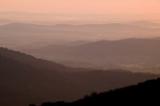Ecoregions 101
Ecoregions 101
A terrestrial ecoregion is a regional landscape that supports recognizably distinctive groupings of plants, animals, and natural communities due to regional patterns of climate, landform, soil, and hydrology.
As a means of setting priorities and conserving biological diversity, ecoregions provide the context to begin asking and answering the question, “What might this natural landscape look like?”
Reflecting natural geographic units, ecoregions are more effective for conservation planning than political and jurisdictional boundaries like states and counties. Ecoregions let us visualize large ecologically related areas and view the distribution of species, habitats, and ecosystems across large regions of the country. They provide a structure for understanding relative representation of different habitat types, and by partitioning states into ecologically-based subunits for conservation purposes.
Numerous federal agencies and conservation organizations have developed ecoregional interpretations of the United States in the past two decades. LandScope America has adopted ecoregion boundaries that combine work by The Nature Conservancy with underlying source maps from USDA Forest Service and US Environmental Protection Agency. This interpretation results in 67 terrestrial ecoregions overlapping the conterminous (lower 48) United States.
This map depicts ecoregions from a terrestrial perspective. That is, they are defined by careful consideration of patterns in upland and wetland vegetation and their environmental drivers. Others have developed ecoregions from an aquatic perspective, considering some similar factors, such as regional climate and soils, but aquatic biodiversity (especially fish and aquatic invertebrates) can be strongly driven by factors such as connectivity to large water bodies and continent-scale patterns in zoogeography (see Abell et al. 2008).
Ecoregion-based conservation highlights the biological importance of certain areas given their contribution to the regional natural landscape. They can also effectively describe patterns in the inherent capabilities of land and water resources and the effects of management on them. Understanding these natural patterns in ecosystems and land use capabilities helps us to more effectively reconnect fragmented landscapes to recover and sustain biodiversity. As climates change, and species need to move across changing landscapes, re-establishing these connections become all the more urgent.






